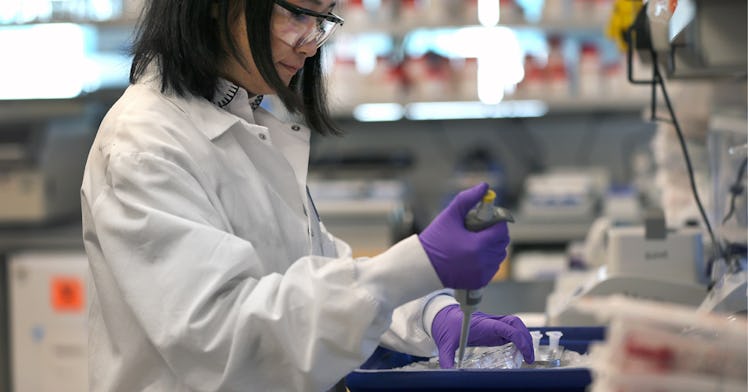What Happens If There Are Two Coronavirus Vaccines?
With Moderna and Pfizer both looking for emergency approval, experts see hope. The more vaccines, the merrier.

Moderna released the preliminary results of its COVID-19 vaccine trial on Monday, and they should give you a sigh of relief: The vaccine is a whopping 94.5 percent effective. Moderna’s report comes just one week after Pfizer announced that its vaccine is more than 90 percent effective. Both vaccines are on track for emergency approval this year. That’s good news for everyone who wants life to go back to normal (that is, everyone). But what happens if both coronavirus vaccines make the cut?
Actually, that would be the best-case scenario. The more COVID-19 vaccines there are, the better off everyone will be. That’s for one simple reason: One manufacturer cannot make enough vaccines to immunize everyone in the world, or even everyone in the U.S. Moderna estimates that it will produce 20 million vaccines for the U.S. by the end of 2020. By the end of 2021, the company is on track to produce 500 million to 1 billion doses globally. Pfizer projects that it will have up to 50 million vaccines made by the end of 2020 and 1.3 billion by the end of 2021. For both vaccines, a booster shot is needed several weeks after the first injection, so every person needs two doses of the vaccine.
“This is a global problem, and no one company is going to have the solution,” John Shiver, senior vice president for global vaccine research and development at Sanofi, a French pharmaceutical company, told Time. “Because we don’t know what will work, what will work best or what will best serve the need in really, really stopping the pandemic, more shots on goal are important.”
Experts expect some vaccines will work better in some populations than others. For example, one vaccine might work better for certain age groups. Once multiple vaccines are available, healthcare providers will decide which is best for each individual. “It’s actually a wonderful thing that we have multiple vaccines in development, because it may be that some of the vaccines will work better in older people, some may be more effective in younger people, some may have fewer side effects in certain populations,” said Peter Marks, a director of the Center for Biologics Evaluation and Research at the Food and Drug Administration, on the podcast FDA Insights.
Issues with distribution are another reason why more vaccines are better. Pfizer’s vaccine must be stored and shipped at the ultra cold temperature of -70 degrees Celsius, which not every medical facility is able to maintain. Once brought out of sub-freezing temperatures, the vaccine lasts for five days in a refrigerator. All those doses — about 1,000 to 5,000 per box — must be used up in less than a week, or else they’ll go bad. It may be difficult for healthcare providers to administer that many doses that quickly in less densely populated areas. Moderna’s vaccine on the other hand must be stored at -20 degrees Celsius, which is much more manageable, and they are viable for 30 days at normal refrigerator temperatures.
Vaccines will go to those most at risk at of severe complications first. The Centers for Disease Control and Prevention is still figuring out exactly who is included in that group, but it will probably be some combination of healthcare workers and nursing home residents with underlying conditions. (Children, who are at low risk and who aren’t included in most vaccine trials, are likely to be the last to get the vaccine.) The idea is to vaccinate those most at risk until we reach herd immunity, or protection for individuals from COVID-19 due to a large chunk of the population being immune. Experts aren’t yet sure what percentage of the population needs to be vaccinated to reach herd immunity.
Moderna and Pfizer together project they will have enough vaccines for the entire U.S. population by spring 2021, according to Science. But once vaccinated, life will not immediately revert back to normal. People who are vaccinated will still have to wear masks and social distance until there’s clear evidence that COVID-19 vaccines alone are able to curb the pandemic. After all, the vaccines may not completely prevent infection.
In normal times, there would still be a long road ahead for both Moderna and Pfizer as they continue trials and accrue data. But in the midst of a pandemic, they will most likely apply for emergency use authorization from the Food and Drug Administration in the next few weeks.
Even with this rollout, the vaccine will likely take a lot of time to make the U.S. population immune, but to have two vaccines with high efficacy is very, very promising. Anthony Fauci, the top infectious disease specialist in the U.S. and an avid baseball fan, told Science, “If we have really good uptake throughout the country, and 95% vaccine efficacy, the blanket of immunity that we could have in this country could really dramatically end this as an outbreak,” Fauci says. “There will still be infections in society, but they likely would be so low that it would be possible to have some spectators in the stands in the summer.”
This article was originally published on